ST KILDA ROAD
MELBOURNE AND SOUTHBANK AND ST KILDA, MELBOURNE CITY, PORT PHILLIP CITY
-
Add to tour
You must log in to do that.
-
Share
-
Shortlist place
You must log in to do that.
- Download report
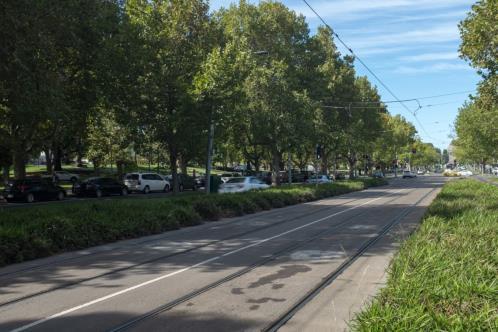

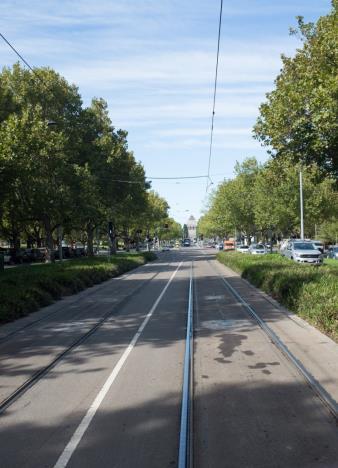
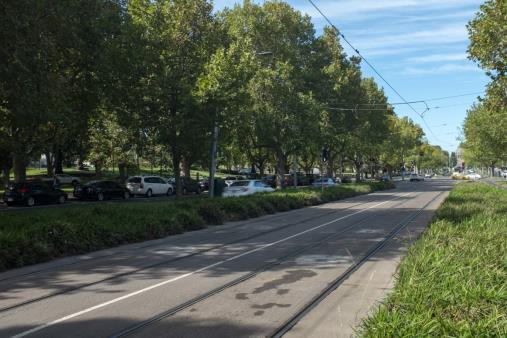
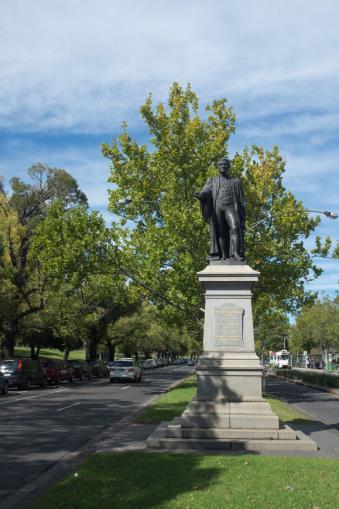
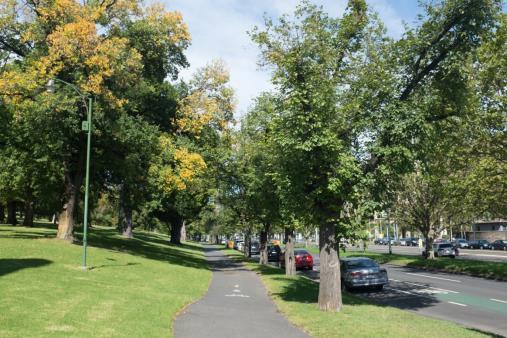
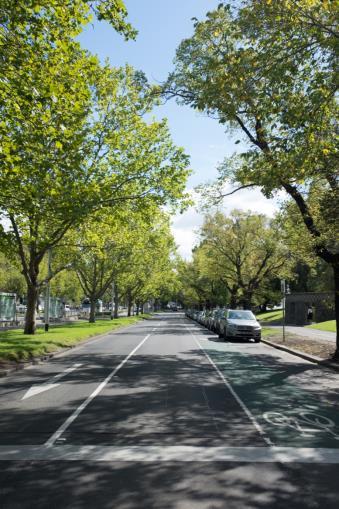
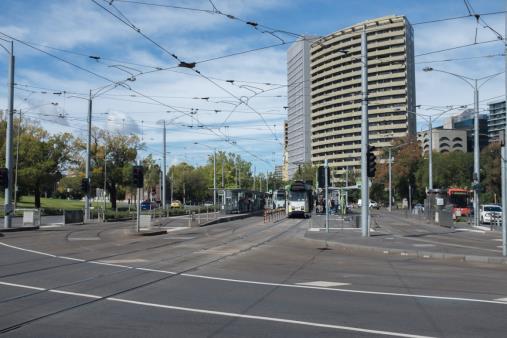
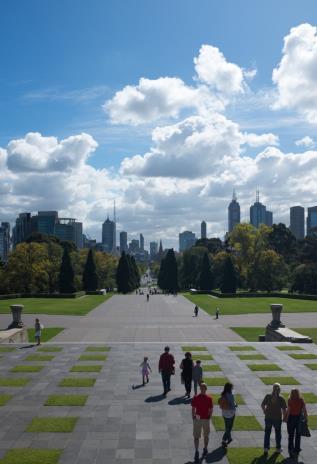
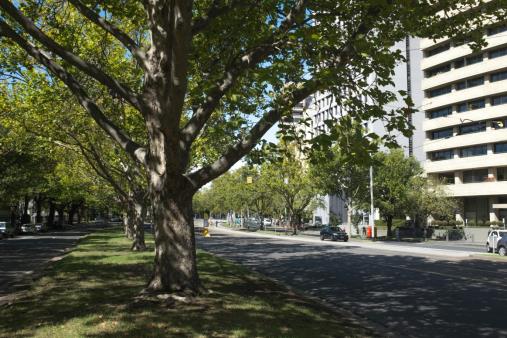
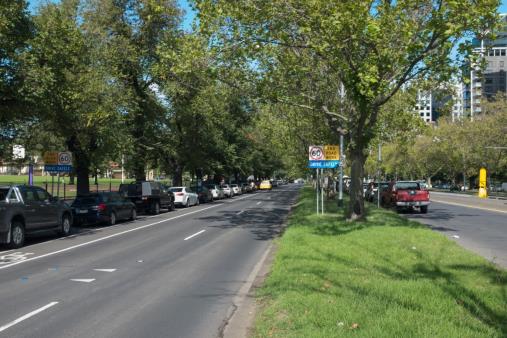
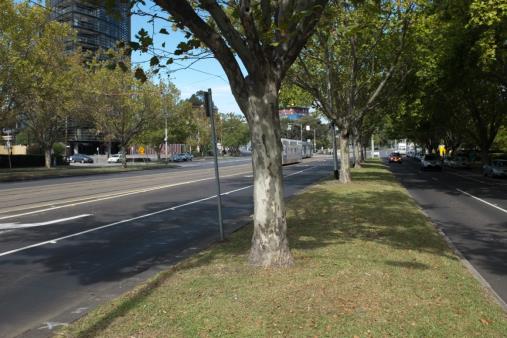

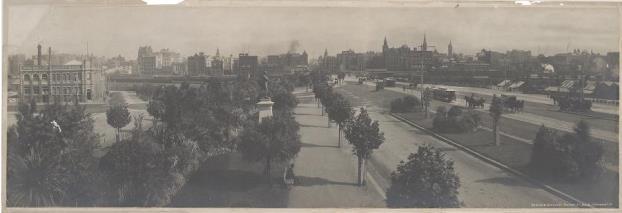
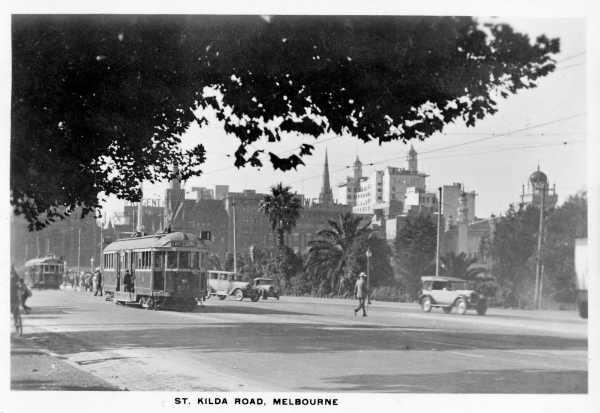
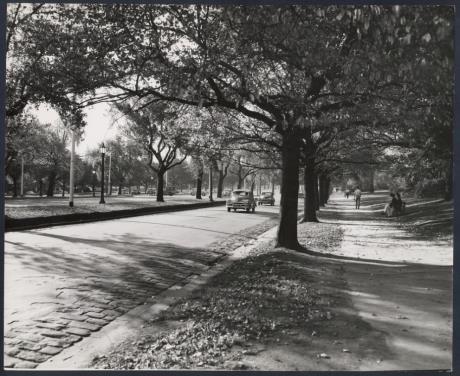
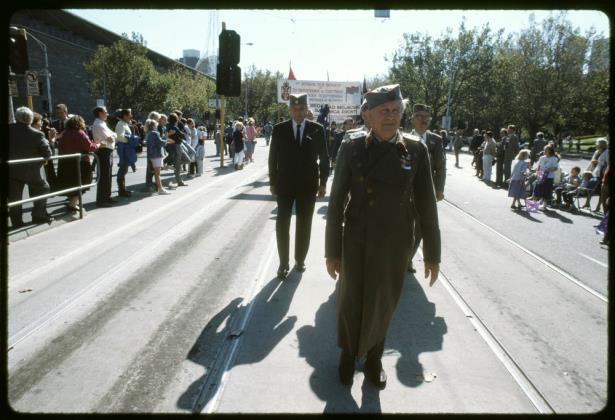
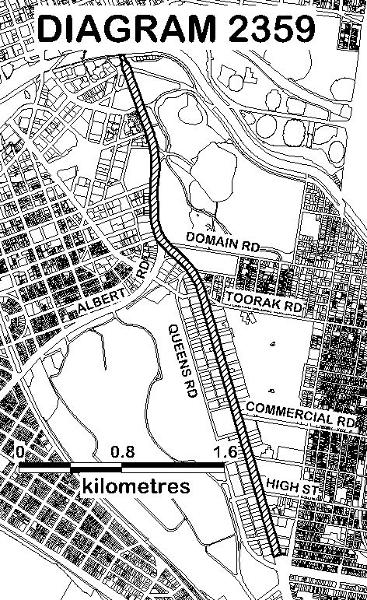
Statement of Significance
What is significant?
How is it significant?
Why is it significant?
-
-
ST KILDA ROAD - History
St Kilda Road developed from an 1830s track known as Baxter's Track, a bush track which led southwards to the St Kilda Hill and Baxter's Stockyard at the corner of Robe and Acland Streets. As early as the 1840s, the east side of St Kilda Road was chosen as the location of public institutions. The first Immigrants Home was established in the early 1840s near the Yarra River and Governor La Trobe had reserved a site for a Government House on an elevated location on the Domain by 1840. In 1842, the first sales of Crown land at St Kilda took place, and an 1843 advertisement made an early mention of a track to St Kilda from Melbourne. By 1847, residents of St Kilda and the Melbourne Corporation had agreed to donate £25 each towards improving the 'highway' from St Kilda to Melbourne, although little was done until the 1850s. St Kilda Road was also known as the Brighton Road in this period, with the growth of Brighton also influencing the road's use and development, with coach services connecting both localities to Melbourne. The first stone bridge crossing the Yarra River was opened in 1850.
In 1853, the Melbourne Central Road Board instructed an engineer to survey St Kilda Road from Princes Bridge to St Kilda Junction with a view to improvements. The Roads Act of 1853, which provided for wide roadways for a number of radial routes from Melbourne, indicates that the then Surveyor-General Robert Hoddle envisaged the growing town as a future city. St Kilda Road was a main thoroughfare by the early 1850s and the 1853 Roads Act designated its 3 chains (60m) width. The line of the road can be seen on a plan of 1858, and broadly reflects the existing alignment. Further institutions were established along St Kilda Road in the 1850s and 1860s, including the Military Barracks (1854); Melbourne Grammar School (1856); the Observatory (1861); Wesley College (1865); the Deaf and Dumb Institute and School for the Blind (both 1866). Government House was constructed off St Kilda Road in the Domain parklands in 1871-75, and the Jewish Almshouses near St Kilda Junction were established in 1870. Likewise, the Domain parklands were developed at the northern end of the road through the nineteenth century. In 1867, the northern end St Kilda Road was used as part of the ceremonial route from Sandridge (Port Melbourne) for the arrival of the Duke of Edinburgh to Melbourne. Historian Judith Buckrich recounts how: the procession had fifty carriages and as it wound into St Kilda Road it was met by a group of schoolboys, including a contingent from Wesley College who presented arms. Closer to the bridge, the women at the Immigrants Home were standing on raised benches especially erected so they could see easily the Prince and procession. In the mid-1870s, the first allotments along St Kilda Road, near Fawkner Park, were auctioned for residential development.
With the construction of Government House at the Domain in the 1870s, St Kilda Road also assumed a ceremonial role, with royal and vice-regal processions from either this official residence or from St Kilda pier arriving in the city along St Kilda Road. Such events have included a seventeen-gun salute from Princes Bridge Battery in honour of the Governor and his party proceeding to the opening of the International Exhibition of 1880 and the celebratory route taken by the Duke of Cornwall and York (later King George V) from Government House to the Royal Exhibition Building to open the Australian Federal Parliament in 1901. The Federation procession proceeded the length of St Kilda Road from St Kilda Junction, where a triple archway bearing the words 'Prahran', 'St Kilda' and 'welcomes' had been constructed. Improvements were undertaken to St Kilda Road in the late 1880s, prompted by the introduction of cable tramways along the length of the road in 1888, with works 'which will make that thoroughfare the noble entrance it ought to be to the city of Melbourne from the south.' By August 1889, these improvements had been completed, comprising separated traffic grades and planted medians. The Leader newspaper described the improved road: After leaving Princes Bridge the spectator finds that the thoroughfare - which is 3 chains wide - comprises the tramway, with pathways on either side, carriage drives beyond and side walks at the extreme east and west sides of the road. In fact there are three roadways and four footpaths, the latter handsomely planted with trees. Twelve months ago a contract was let to Messrs. M Gardiner and Co for forming the roads and pathways, metalling the roads and kerbing channelling and asphalting the footways. The contract also included tree planting and certain works in connection with underground drainage ... The triple road runs from Princes Bridge as far as the Domain Road. Beyond that there are to the west of the tramway a carriageway and two footpaths and to the east a series of little plantations fenced in. (Leader, 17 August 1889, quoted in Judith Buckrich, Melbourne's grand boulevard, p. 68) The road was soon after referred to as a 'boulevard', in a description of the arrival of the new Governor, the Earl of Hopetoun, which again highlighted its role for ceremonial occasions: 'The cheering is but feeble until the procession debouches upon the great boulevard of the St Kilda Road. Here for the first time the new Governor is able to see a Melbourne crowd in its full strength.' (Camperdown Chronicle, 30 November 1889, p. 2)
Photographs from the end of the nineteenth century, show the boulevard arrangement, including rows of trees separating traffic, extended the length of St Kilda Road to its intersection with, approximately, Henry Street. This layout can be seen on the MMBW detail plans of the mid-1890s. The road was widened to 60 metres along its entire length in 1904. A memorial to Edmund Fitzgibbon, former town clerk of Melbourne and first chairman of MMBW, erected on one of the medians near Princes Bridge in 1908, with a statue to Robert Burns located opposite on a reserve on the western side of the road. In 1926, cable trams were replaced with electric trams, and the need to protect the 'grand avenue' during this process was acknowledged. The ceremonial and symbolic importance of St Kilda Road was further enhanced with the construction of the Shrine of Remembrance in 1934. The selection of the site was important as it enabled the memorial design to incorporate the vista looking south along Swanston Street and St Kilda Road. A gap in the plantations was also opened up on the east side of the avenue plantations where the Shrine forecourt meets St Kilda Road at Anzac Avenue. This was undertaken in the post-war years apparently as a deliberate design conceit to visually link the Shrine with the northern section of St Kilda Road. The aesthetic qualities of St Kilda Road were recognised by planners and writers both locally and interstate. Improvements undertaken in 1914 prompted the Argus to declare: 'St Kilda road . is rapidly become one of the most beautiful portions of the metropolis; the pride of its citizens, and the admiration of the thousands who travel along it.' (Argus, 14 January 1914, p. 18)
In the interwar period councillors and politicians expressed their desire to emulate the 'beautiful St Kilda Road' in local roads in Footscray, Geelong, Williamstown, Brighton, Brisbane and Adelaide. (See for example Werribee Shire Banner, 11 December 1924, p. 3, Advertiser, 4 July 1933, p. 10, Sunday Mail, 14 October 1945, p. 5, Record, 26 July 1924, p. 4, Prahran Telegraph, 7 December 1928, p. 2.) Newspaper descriptions included 'the spacious boulevard', 'the most famous of Melbourne's broad and stately thoroughfares', 'Melbourne's Pride: St Kilda Road', 'the world-famed St Kilda Road', and 'our loveliest boulevard'. (Prahran Telegraph, 28 March 1901, p. 2 and Argus, 20 October 1934, p. 8, 26 March 1949, Supplement p. 1, 20 May 1953, p. 2, Age, 19 May 1953, p. 4.) In 1938, the Age newspaper concluded its 'Great Streets of the World' series with an article on St Kilda Road. The series profiled other major streets in Europe, North America and South America, including the Calle de Alcala in Madrid; the Champs Elysees, Paris; Unter den Linden, Berlin; Broadway, New York; Avenue de Mayo, Buenos Aires and Avenido Rio Branco, Rio de Janiero. (Age, supplement editions, 16 September 1937-7 May 1938.) Of St Kilda Road the newspaper noted: When General Pau paid a visit to our city he is reported to have said that 'St Kilda- road made the boulevards of Paris look silly. Unbiased judges will agree with the verdict. The layout of St Kilda-road in itself is impressive. It is not merely a road, but a series of roads and footpaths separated by ornamental plantations of palms and trees . it is a noble stretch of road, half avenue, half street, and as it nears the city it bursts into supreme beauty of lawns, flowers, trees and pathways, and is happy to make friends with a worthy bridge and an historic river. (Age, 7 May 1938, supplement, p. 3)
With the 1950s rezoning of land along St Kilda Road to allow for non-residential development, the character of the built form along St Kilda Road began to change, with the demolition of nineteenth century residences and construction of commercial and office buildings. However, the road itself has retained its boulevard arrangement, and community appreciation of it continued into the late twentieth century. In the twentieth century, the National Gallery and the Victorian Arts Centre were constructed on the west side of St Kilda Road, continuing the nineteenth century preference for important public institutions to be located along it. St Kilda Road continued to be used for commemorative purposes through the twentieth century, including the annual Anzac Day marches from Swanston Street to the Shrine, protests and Moomba Parades. In both 1996 and 1999, there were campaigns to the City of Melbourne to rename the thoroughfare St Kilda Boulevard, to give St Kilda Road the 'status it deserved', although both were ultimately unsuccessful.
St Kilda Road continues to be the southern 'gateway' to Melbourne and an important thoroughfare connecting the southern suburbs with the city, and retains its role as a location for public ceremonies and gatherings. Today the aesthetic qualities of St Kilda Road are commonly written about in the context of the place as a tourist destination:
Take a stroll or a tram along this majestic tree-lined boulevard... Feel Melbourne's beating pulse as you veer off and onto St Kilda Road, the city's tree-lined main artery and gateway to lush parks and well-known landmarks'. (visitvictoria.com)
References
Judith Buckrich, Melbourne's grand boulevard: the story of St Kilda Road, State Library of Victoria, Melbourne, 1996.
Lovell Chen, Nomination Of St Kilda Road to The Victorian Heritage Register, Supporting Documentation, Prepared for Melbourne Metro Rail Authority December 2015.
ST KILDA ROAD - Plaque Citation
One of Melbourne's grandest major thoroughfares, this 1850s tree-lined boulevard is an iconic part of Melbourne's urban landscape. With sweeping views between the Shrine of Remembrance and the Melbourne CBD, it has been used for important ceremonial and celebratory processions.
ST KILDA ROAD - Assessment Against Criteria
Criterion
St Kilda Road is significant at the State level for the following reasons:
St Kilda Road is historically significant as one of Melbourne's longest and grandest major thoroughfares. For over a century this European-style boulevard has had an iconic status as the southern gateway to the city. Dating from the 1850s, St Kilda Road was developed into a magnificent tree-lined boulevard during the late nineteenth century and was the location of some of Victoria's major public institutions. From the 1880s Melbourne's wealthy constructed impressive residences at this prestigious address, and from the 1950s it became a centre for commercial activity. St Kilda Road has been used for ceremonial and celebratory processions including those associated with the Duke of Edinburgh's visit to Melbourne in 1867, the opening of the International Exhibition of 1880, and the opening of the Australian Federal Parliament in 1901. It remains the site of Victoria's annual Anzac Day march, Moomba parades and political protests. [
Criterion A]
St Kilda Road is significant as a fine and representative example of a boulevard. It was one of the first of Melbourne's main roads (Royal Parade, Flemington Road, Dandenong Road and Queens Parade) to be laid out as a boulevard around 1889, and is the longest metropolitan boulevard in Melbourne. Boulevards are wide and tree-lined roads which often separate traffic types with medians strips. They are an urban design form which characterised the development of European cities from the 1750s and became evident in Australia from the mid-nineteenth century. St Kilda Road demonstrates the characteristics of a boulevard at a high level, with consistent medians and trees extending almost the whole length of the road, for approximately four kilometres, although there is variation in the intactness of some of the plantings. St Kilda Road has developed over time to safely accommodate many different forms of traffic, including trams, cars, bicycles and buses. [
Criterion D]
St Kilda Road is of aesthetic significance as an iconic boulevard which has been recognised as a place of beauty and a visually outstanding element in Melbourne's urban landscape. A broad and stately thoroughfare, its intact and impressive plantings of mature Elm and Plane trees beautify the southern access to the city. The overarching tree canopies are of considerable visual appeal, provide a sense of enclosure and exemplify the aesthetic use of trees as a road design device. The sweeping views between the Shrine of Remembrance, St Kilda Road and Swanston Street are significant for their emphasis on St Kilda Rd as a processional route between the Shrine and the city. There are also important visual associations with the Queen Victoria Garden and Domain parklands to the east. [
Criterion E]
ST KILDA ROAD - Permit Exemptions
General Exemptions:General exemptions apply to all places and objects included in the Victorian Heritage Register (VHR). General exemptions have been designed to allow everyday activities, maintenance and changes to your property, which don’t harm its cultural heritage significance, to proceed without the need to obtain approvals under the Heritage Act 2017.Places of worship: In some circumstances, you can alter a place of worship to accommodate religious practices without a permit, but you must notify the Executive Director of Heritage Victoria before you start the works or activities at least 20 business days before the works or activities are to commence.Subdivision/consolidation: Permit exemptions exist for some subdivisions and consolidations. If the subdivision or consolidation is in accordance with a planning permit granted under Part 4 of the Planning and Environment Act 1987 and the application for the planning permit was referred to the Executive Director of Heritage Victoria as a determining referral authority, a permit is not required.Specific exemptions may also apply to your registered place or object. If applicable, these are listed below. Specific exemptions are tailored to the conservation and management needs of an individual registered place or object and set out works and activities that are exempt from the requirements of a permit. Specific exemptions prevail if they conflict with general exemptions. Find out more about heritage permit exemptions here.Specific Exemptions:It should be noted that Permit Exemptions can be granted at the time of registration (under s.42(4) of the Heritage Act). Permit Exemptions can also be applied for and granted after registration (under s.66 of the Heritage Act)
General Condition 1
All exempted alterations are to be planned and carried out in a manner which prevents damage to the fabric of the registered place or object.
General Condition 2
Should it become apparent during further inspection or the carrying out of works that original or previously hidden or inaccessible details of the place or object are revealed which relate to the significance of the place or object, then the exemption covering such works shall cease and Heritage Victoria shall be notified as soon as possible.
General Condition 3
All works should be informed by Conservation Management Plans prepared for the place. The Executive Director is not bound by any Conservation Management Plan, and permits still must be obtained for works suggested in any Conservation Management Plan.
General Condition 4
Nothing in this determination prevents the Heritage Council from amending or rescinding all or any of the permit exemptions.
General Condition 5
Nothing in this determination exempts owners or their agents from the responsibility to seek relevant planning or building permits from the relevant responsible authority, where applicable.
Specific Permit Exemptions
Landscape Exemptions
. The process of gardening, including mowing, hedge clipping, bedding displays, removal and replanting of shrubs, disease and weed control, and maintenance to care for existing plants.
. The removal or pruning of dead, dying or dangerous trees as assessed by a qualified Arborist to maintain safety. If the tree is identified as being of primary or contributory cultural heritage significance, the Executive Director must be notified of these works within 21 days of them being undertaken.
. Management of trees in accordance with Australian Standard; Pruning of Amenity Trees AS 4373-2007.
. Management of trees in accordance with Australian Standard; Protection of Trees on Development Sites AS 4970-2009.
. Subsurface works involving the installation, removal or replacement of watering and drainage systems or services outside the canopy edge of significant trees in accordance with AS4970 and on the condition that works do not impact on archaeological features or deposits.
. Removal of plants listed as noxious weeds in the Catchment and Land Protection Act 1994
. Vegetation protection and management of possums and vermin.
. Tree planting (with same species) and replacement trees for any tree removed in accordance Australian Standard; Tree stock for landscape use AS 2303:2015.
. Nature strip works involving porous hard and soft surfaces that include rock pave, concrete or bluestone edges, grass and granitic sand, outside the tree protection zone.
. Median strip works involving porous hard and soft surfaces that include rock pave, concrete or bluestone edges, grass and granitic sand, outside the tree protection zone.
Road Reserve exemptions
. All works to maintain the existing roadway and road safety including road surface, shoulder and footpath maintenance, kerbs and channel repairs, road line marking (including for bicycle lanes), speed humps or platforms, pedestrian refuges and splitter islands or separators within the existing roadway, and the installation of pedestrian crossings, traffic signs, signals and associated infrastructure, fire hydrants, drains, parking meters and post boxes. This exemption does not include the replacement of any bluestone kerbing or guttering/channels.
. Repairs and maintenance to hard landscape elements, structures, sculptures, statues, memorials, rockwork, steps, paths, gutters, drainage and irrigation systems, edging, fences and gates and lighting.
. Repairs and maintenance of culverts, kerbs, gutters, drainage works, pavement marking and traffic signs.
. Repairs and maintenance of existing crossovers, driveways and paths that do not require the removal or lopping of trees and significant vegetation.
. Road marking.
. Repair, maintenance and replacement of traffic signals and signage.
. Repairs and Installation and maintenance of services in roadways and footpaths. However works that would impact on any part of place such as any landscaped areas, verges, median strips, nature strips, trees and tree roots may require either a specific permit exemption or permit approval.
. Maintenance, removal or installation of underground utilities if outside the tree protection zone.
Tramway and bus exemptions
. Repairs and maintenance of existing tramway infrastructure, including tram stops, barriers, signage, platforms, shelters, overhead wiring and tram poles.
. Repairs and maintenance of existing bus infrastructure, including bus stops.
Street furniture
. Installation of standard City of Melbourne and City of Port Phillip street furniture, including seats, bins, signage, bollards, lights and drinking fountains which has no negative impact on the cultural heritage significance of the place.
. The placement of removable tables, chairs, umbrellas, heaters, and non-permanent wind screening and barriers necessary for the operation of hospitality/cafe/restaurant businesses along St Kilda Road. This excludes awnings.
Events
. Preparation for and delivery of City of Melbourne and City of Port Phillip events (including the Anzac Day Parade, White Night, the Moomba Parade and other events delivered by external organisations approved by the City of Melbourne and the City of Port Phillip) for a period of up to 7 days, including the temporary erection of infrastructure that has no negative impact on the cultural heritage significance of the place.
. Events of a longer period or having the potential to impact on the road, trees, median strips, footpaths and features will require the submission of a management plan to be approved by the Executive Director. In this case the event would normally be considered under the Minor Works provisions of the permit exemptions and s66.(3) Heritage Act 1995.
ST KILDA ROAD - Permit Exemption Policy
Preamble
The purpose of the Permit Policy is to assist when considering or making decisions regarding works to a registered place. It is recommended that any proposed works be discussed with an officer of Heritage Victoria prior to making a permit application. Discussing proposed works will assist in answering questions the owner may have and aid any decisions regarding works to the place.
The extent of registration of St Kilda Road in the Victorian Heritage Register affects the whole place shown on Diagram 2359 including the land, all buildings, roads, trees, landscape elements and other features. Under the Heritage Act 1995 a person must not remove or demolish, damage or despoil, develop or alter or excavate, relocate or disturb the position of any part of a registered place or object without approval. It is acknowledged, however, that alterations and other works may be required to keep places and objects in good repair and adapt them for use into the future.
If a person wishes to undertake works or activities in relation to a registered place or registered object, they must apply to the Executive Director, Heritage Victoria for a permit. The purpose of a permit is to enable appropriate change to a place and to effectively manage adverse impacts on the cultural heritage significance of a place as a consequence of change. If an owner is uncertain whether a heritage permit is required, it is recommended that Heritage Victoria be contacted.
Permits are required for anything which alters the place or object, unless a permit exemption is granted. Permit exemptions usually cover routine maintenance and upkeep issues faced by owners as well as minor works or works to the elements of the place or object that are not significant. They may include appropriate works that are specified in a conservation management plan. Permit exemptions can be granted at the time of registration (under s.42 of the Heritage Act) or after registration (under s.66 of the Heritage Act).
It should be noted that the addition of new structures to the registered place, as well as alterations to the interior and exterior of existing buildings requires a permit, unless a specific permit exemption is granted.
Conservation management plans
It is recommended that a Conservation Management Plan is developed to manage the place in a manner which respects its cultural heritage significance.
Other approvals
Please be aware that approval from other authorities (such as local government) may be required to undertake works.
Archaeology
Ground disturbance may affect the significance of the place and, subject to the exemptions stated in this document, requires a permit.
Cultural heritage significance
Overview of significance
St Kilda Road is historically significant as one of Melbourne's longest and grandest major thoroughfares. For over a century this European-style boulevard has had an iconic status as the southern gateway to the city. Dating from the 1850s, St Kilda Road was developed into a magnificent tree-lined boulevard during the late nineteenth century. Its significance is evident across the width of the full carriage way including the grassed medians, kerbing, bluestone kerbs and channels, footpaths and consistent tree plantings. It is of aesthetic significance as a place of beauty and a visually outstanding element in Melbourne's urban landscape. The sweeping views between the Shrine of Remembrance, St Kilda Road and Swanston Street are significant for their emphasis on St Kilda Rd as a processional route between the Shrine and the city. There are also important visual associations with the Queen Victoria Garden and Domain Parklands and Alexandra Gardens to the east.
-
-
-
-
-
SHRINE OF REMEMBRANCE
 Victorian Heritage Register H0848
Victorian Heritage Register H0848 -
FORMER KELLOW FALKINER SHOWROOMS
 Victorian Heritage Register H0668
Victorian Heritage Register H0668 -
PARK HOUSE
 Victorian Heritage Register H0224
Victorian Heritage Register H0224
-
CONVINCING GROUND
 Victorian Heritage Register H2079
Victorian Heritage Register H2079 -
MERINO DOWNS HOMESTEAD COMPLEX
 Glenelg Shire
Glenelg Shire -
MUNTHAM HOMESTEAD COMPLEX
 Southern Grampians Shire H0294
Southern Grampians Shire H0294
-
-












